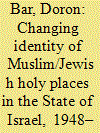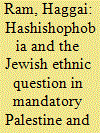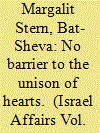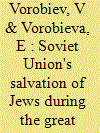|
|
|
Sort Order |
|
|
|
Items / Page
|
|
|
|
|
|
|
| Srl | Item |
| 1 |
ID:
164917


|
|
|
|
|
| Summary/Abstract |
This article examines the virtually unexplored topic of the Baha'i religious minority in Israel's early statehood period based mainly on primary source documentation. It will be argued that while the number of Persian Baha'is in Israel after 1948 was minuscule — even smaller than the similarly minuscule Circassian and Armenian populations — the non-Arab and non-Muslim identity of the Baha'is, the lack of any historical antagonism between the Baha'is and the Jews, a shared history of marginalization in the modern Middle East, the Baha'is' principled commitment to non-violence as a basic tenet of their religious faith, their complete neutrality leading up to and including the 1948 War, (and their support for Jewish statehood after it), their lack of proselytizing in the state of Israel, and the fact that nearly all of their high-ranking administrators in post-independence Israel hailed from the United States — whose support Israel sought — led the state to cultivate this minority to a degree few other minorities experienced in post 1948 Israel.
|
|
|
|
|
|
|
|
|
|
|
|
|
|
|
|
| 2 |
ID:
192287


|
|
|
|
|
| Summary/Abstract |
Over the past seven decades, dozens of Muslim holy places in Israel have undergone a process of Judaization, becoming an integral part of the Israeli-Jewish sacred landscape. The current paper compares three waves of Judaization that followed the 1948 and 1967 wars, emphasizing the institutional and popular character of this process. The appropriation of Muslim holy places and their conversion is tied to the political, social, and religious changes that Israeli society underwent during its seventy years of existence. During these decades, Jewish holy spaces gained social, cultural, and religious importance; visiting them became a popular pastime. As the demand for holy places grew, former Muslim sites were converted and became part of Jewish sacred space. The process of transformation took place in parallel on two planes – the institutional and the popular – as both Israeli governmental bodies and worshipers converted Muslim holy places into Jewish sacred sites. The outcome of the process was the expansion of sacred space in the State of Israel and the inclusion of the periphery, which in many cases contained former Muslim holy places, as an integral part of the Jewish map of holy places.
|
|
|
|
|
|
|
|
|
|
|
|
|
|
|
|
| 3 |
ID:
181016


|
|
|
|
|
| Summary/Abstract |
By drawing on crime fiction, press commentaries and archival records, this article explores Jewish public discourse about hashish in Mandatory Palestine and the first two decades of the State of Israel. Fearing over-assimilation into the Levant, Jews in interwar Palestine shunned the drug, considering it a form of ‘backwardness’ linked to the realities of living among Arabs in the Middle East. Colonial knowledge about hashish (as well as Orientalist fantasies) validated these fears, appearing to confirm that hashish was an Oriental substance that animated the pathologies inhering in Arab mentalities. This knowledge survived the transition to the Israeli state by responding to new realities: the expulsion and flight of the Arab population and the country’s repopulation by Jews from the Muslim world (Mizrahim). Some of these Jews had used hashish in their countries of origin and brought the habit with them to Israel. Others began to smoke hashish in Israel due to their socio-ethnic marginalization. Although hashish smoking in Israel in the 1950s and much of the 1960s remained limited to a few thousand members of the Mizrahi underclass, it rekindled middle-class fears of Levantinization-cum-Arabicization of the Jewish state. It also assisted in further marginalizing Mizrahim in Israeli society.
|
|
|
|
|
|
|
|
|
|
|
|
|
|
|
|
| 4 |
ID:
187059


|
|
|
|
|
| Summary/Abstract |
Since October 2020 there is a new actor in Israel’s maritime space and energy sector after the Chevron Corporation acquired Noble Energy. This article examines the first year under the headings: financial aspects, regional politics, the UAE and the Abraham Accords, the EastMed natural gas pipeline, security aspects, Chevron and local companies and scandals and environmental aspects. The analysis determines the historical significances and projects ways forward, for a win–win outcome for Chevron and Israel. Chevron has ability to make the EastMed pipeline happen may also have positive ramifications for regional politics. Israel as a regulator will not permit Chevron to gain a larger stake of the gas fields, or even increase prices to the IEC and so to consumers. Israel will aim to ensure that Chevron will not cut corners that could result in labour issues, health and safety dangers, and environmental catastrophe. The Israel Navy has procured four new warships, to meet the gas fields’ direct security needs, permitting a Brown Water doctrine shift while enabling enhanced power projection capability.
|
|
|
|
|
|
|
|
|
|
|
|
|
|
|
|
| 5 |
ID:
177274


|
|
|
|
|
| Summary/Abstract |
Between 1948 and1967, Muslim cemeteries in the State of Israel saw many changes. The present article examines how the state elected to treat the many deserted Muslim cemeteries within its limits: should these cemeteries be protected by the Jewish state? Or should they be demolished, their remains removed from the evolving Israeli landscape? Israeli archival sources facilitate the study of this phenomenon, highlighting the duplicitous nature of the Israeli bureaucratic approach toward Muslim cemeteries. Charged with safeguarding the sites, the Ministry of Religious Affairs’ Muslim and Druze Department attempted to confront the state’s propensity to evacuate the cemeteries and use the vacant space for different needs. Yet, at the same time, other Israeli actors – various governmental offices, municipalities, and even the army – played a part in the process of neglect, damage, and appropriation that these cemeteries suffered.
|
|
|
|
|
|
|
|
|
|
|
|
|
|
|
|
| 6 |
ID:
160298


|
|
|
|
|
| Summary/Abstract |
A coalition of women from all walks of life was common in women’s activism at the beginning of the twentieth century. The recognition of the importance of the empowerment of women through autonomous, public activity was also shared among the women’s organisations that decided to cooperate in the political arena in Eretz Israel. Their collaboration indicates the importance they attached to the commitment to united action that was based on the acceptance of Zionist principles, on the one hand, and their aspiration to overcome what separated them, on the other. The women’s coalition overcame geographical distance and differences in class or political and social orientation, while challenging the old consensus and the boundaries of exclusion and inclusion prevailing in Zionist society. This article focuses on the collaboration between women’s organisations of labour Zionism and middle-class Zionism of various national affiliations, thus forming a transnational coalition in the build-up to statehood. Their claims, activities and modes of operation in the fields of politics and economics are analysed alongside the results and the effect of their efforts.
|
|
|
|
|
|
|
|
|
|
|
|
|
|
|
|
| 7 |
ID:
138487


|
|
|
|
|
| Summary/Abstract |
This year will see the 70th anniversary of the Great Victory, one more illustrious jubilee date commemorating the end of the Great Patriotic War. But this year, along with voices from progressive forces that make objective assessments of events and results of the Second World War, stressing their significance and prominence, in some countries obnoxious (there is no other word) officials are coming forward and so-called historians are waking up who are painting upside-down pictures of all that has to do with that global tragedy.
|
|
|
|
|
|
|
|
|
|
|
|
|
|
|
|
|
|
|
|
|